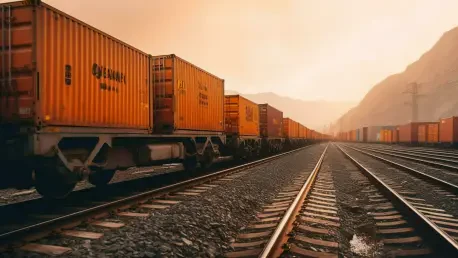Imagine a freight train stretching across miles of rugged terrain, carrying hazardous materials through small towns and bustling cities alike, where one misstep—a track misalignment or a hazmat spill—could spell disaster for communities and the environment. With over 140,000 miles of track crisscrossing the United States, Class I railroads like Union Pacific (UP) and CSX bear the immense responsibility of ensuring safety and efficiency in an industry under constant scrutiny. This roundup gathers diverse perspectives, tips, and reviews from industry stakeholders to explore how these two giants are pioneering rail safety and innovation. The aim is to uncover actionable strategies and inspire broader dialogue on transforming rail transport into a safer, more sustainable sector.
Setting the Track for Progress: The Importance of Rail Safety and Innovation
Class I railroads form the backbone of U.S. freight transport, moving millions of tons of goods annually while navigating complex operational and environmental challenges. Experts across the sector emphasize that safety is not just a regulatory mandate but a critical component of maintaining public trust and operational reliability. Innovations in equipment maintenance and emergency preparedness are often cited as essential to reducing accidents and minimizing ecological impact.
The growing demand for transparency has pushed companies to adopt cutting-edge technologies and protocols. Industry observers note that community well-being hinges on railroads’ ability to prevent incidents and respond swiftly when they occur. This urgency drives the need for sustainable practices and robust safety cultures, areas where UP and CSX have been recognized as leaders.
This discussion compiles insights on specific initiatives, such as sustainable equipment programs and groundbreaking training facilities, to highlight how these companies are shaping industry standards. The perspectives gathered aim to provide a comprehensive view of what works, what challenges persist, and how other players might adapt these lessons.
Pioneering Safety and Efficiency: UP and CSX Under the Spotlight
UP’s Milestone in Equipment Longevity: A Safety-First Perspective
Union Pacific’s achievement in rebuilding its 100th tamper—a machine vital for track stability—has drawn praise from maintenance specialists for its focus on safety and sustainability. Covering over 18,000 miles of track, UP’s program, now in its stride after several years of scaling up, showcases how refurbishing equipment can extend operational life while enhancing worker safety. Industry analysts highlight that such efforts reduce the need for costly new purchases and align with environmental goals by minimizing waste.
Feedback from equipment engineers points to specific upgrades, like ergonomic cab designs and improved component accessibility, as game-changers for operator comfort and efficiency. Data circulating among rail professionals suggests that rebuilt tampers often perform on par with brand-new units, prompting discussions on cost-effectiveness. However, some caution that scaling such rebuilds requires significant investment in training and infrastructure, a hurdle smaller railroads might struggle to overcome.
Contrasting views emerge on whether rebuilding should take precedence over replacement. While many applaud UP’s internal focus on employee-driven innovation, others argue that newer technologies in fresh equipment could offer long-term advantages. This debate underscores a broader industry tension between preserving resources and embracing modern solutions, with UP’s approach serving as a valuable case study for balancing these priorities.
CSX’s Safety Triumph: Four Years of Injury-Free Operations
CSX’s Southeast Region Communications & Signals team has set a remarkable benchmark by achieving four years without a reportable injury, a feat celebrated by safety officers across the rail sector. This accomplishment, rooted in consistent practices like job safety briefings and regular equipment checks, has been hailed as a model for fostering a safety-first culture. Industry commentators stress that such milestones demonstrate the impact of meticulous planning and employee engagement in high-risk environments.
Insights from workplace safety advocates reveal that replicating this success across larger regions or different operational teams poses significant challenges due to varying workloads and conditions. Some suggest that CSX’s emphasis on routine inspections and team accountability offers a blueprint, though it requires sustained leadership commitment. Recognition events, as seen in gatherings at key operational yards, are often cited as morale boosters that reinforce safety priorities.
Differing opinions surface on the scalability of such injury-free records amidst rising operational demands. While many view this as an inspiring target, skeptics warn that maintaining zero incidents over extended periods could strain resources if not paired with adequate staffing and technology support. These perspectives highlight the delicate balance between ambition and practicality in safety initiatives.
CSX’s Vision for Hazmat Preparedness: A Cutting-Edge Facility
CSX’s partnership with a Florida-based college to build a state-of-the-art hazmat training center, slated for completion by early 2026, has generated buzz among emergency response trainers and rail safety experts. Featuring tank cars, simulators, and augmented reality tools, the facility aims to equip first responders and industry professionals with hands-on skills to manage rail-related incidents. Many in the field see this as a proactive step toward mitigating risks associated with transporting hazardous materials.
Regional stakeholders in the Southeast applaud the potential for localized impact, noting that tailored training could enhance community preparedness near busy rail corridors. National safety consultants, however, push for broader replication, arguing that similar centers could standardize emergency response protocols across the country. The innovative use of technology in training is often highlighted as a way to bridge gaps in traditional methods.
Critical voices question whether specialized facilities might overshadow the need for widespread, accessible training programs at smaller scales. Some industry watchers suggest that while the center sets a high bar, its effectiveness will depend on funding and outreach to ensure inclusivity for smaller railroads and rural responders. This diversity of thought underscores the complexity of redefining hazmat preparedness in a varied industry landscape.
Shared Values in Innovation: Sustainability as a Core Driver
Both UP and CSX have garnered attention for embedding sustainability into their safety and innovation strategies, a trend praised by environmental advocates within rail circles. UP’s focus on extending equipment life through rebuilds reduces resource consumption, while CSX’s hazmat training initiative aims to prevent environmental disasters through better preparedness. Observers note that these efforts reflect a shared industry ethos of balancing profitability with accountability.
Comparing their approaches, UP’s internal, employee-centric model contrasts with CSX’s external collaboration with educational institutions, sparking discussion on which strategy holds more promise for long-term impact. Sustainability experts lean toward combining both—leveraging in-house expertise while forging partnerships to address broader challenges. Such hybrid models are often floated as potential influencers of future rail policies.
Additional depth comes from industry trend analyses, which position these companies as frontrunners in an era demanding operational and ecological responsibility. Some argue that their initiatives could pressure regulators to raise standards, while others worry about the cost burden on smaller operators. This spectrum of views illustrates how sustainability is both a unifying goal and a divisive challenge in rail innovation.
Key Lessons from UP and CSX: Industry-Wide Takeaways
The standout achievements of UP and CSX offer a wealth of lessons, as noted by rail operators and policy analysts alike. UP’s tamper rebuild program is frequently cited as evidence that refurbishment can enhance longevity and safety without sacrificing performance, a strategy worth exploring for cost-conscious railroads. CSX’s dual focus on injury prevention and community preparedness through training facilities provides a roadmap for integrating employee and public safety into core operations.
Practical tips from industry forums include investing in modular rebuild programs that can scale with demand and prioritizing safety protocols through regular audits and team incentives. Partnerships, as seen in CSX’s educational collaboration, are recommended for tackling large-scale issues like hazmat response, especially for railroads lacking internal resources. These actionable ideas aim to inspire adaptation across diverse operational contexts.
Stakeholders also stress the importance of weaving safety and sustainability into business models without compromising reliability or profit margins. Insights suggest that transparent reporting on safety metrics and environmental impact can build trust with regulators and communities. These takeaways, drawn from varied perspectives, provide a toolkit for railroads looking to emulate the leadership shown by these two companies.
Looking Down the Line: Shaping the Future of Rail Safety
Reflecting on this roundup, the dialogue around UP and CSX’s contributions revealed a shared commitment to safety, sustainability, and collaboration as pillars of progress in rail transport. Industry voices consistently pointed to these elements as vital in addressing modern challenges like environmental concerns and public perception. The diverse opinions gathered painted a picture of an industry at a crossroads, eager to innovate yet mindful of practical constraints.
As a next step, railroads of all sizes were encouraged to pilot small-scale versions of equipment refurbishment or safety training programs, leveraging lessons from these case studies. Exploring grant opportunities or industry coalitions could offset costs, ensuring broader access to innovative practices. Additionally, staying attuned to evolving regulations and technological advancements was seen as crucial for maintaining momentum.
Beyond immediate actions, the discussions prompted consideration of how collective efforts could redefine rail transport’s role in a sustainable economy. Advocating for standardized safety benchmarks or shared training resources emerged as potential avenues for future collaboration. These insights aimed to spark ongoing conversation and action, ensuring that the strides made by industry leaders continued to inspire transformative change.









